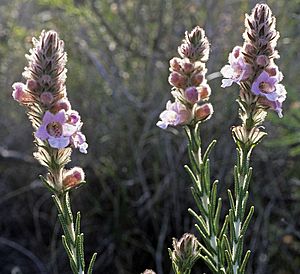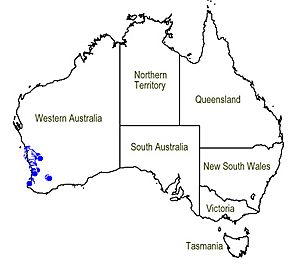Woolly dragon facts for kids
Quick facts for kids Woolly dragon |
|
|---|---|
 |
|
| Hemiphora bartlingii leaves and flowers | |
| Scientific classification | |
| Genus: |
Hemiphora
|
| Species: |
bartlingii
|
 |
|
| Synonyms | |
|
|
The Woolly Dragon (also known as Hemiphora bartlingii) is a cool flowering plant that belongs to the mint family. You can find it only in the south-west part of Western Australia. This plant is a shrub that stands upright, and its branches are covered in greyish, rusty-coloured hairs. Its leaves look a bit bubbly, and it produces pretty white, pink, or purple flowers for a long time.
Contents
What Does the Woolly Dragon Look Like?
The Woolly Dragon is a shrub that usually grows to be about 0.3–0.9 m (1–3 ft) tall. Its branches are covered with thick, greyish, rusty-coloured hairs, which is how it gets its "woolly" name!
The leaves are long and narrow, like a line or a spearhead. They often look almost round because their edges curl strongly inwards. These leaves are about 3–4 cm (1–2 in) long and 3–5 mm (0.1–0.2 in) wide. The top side of the leaf looks a bit bumpy or blistered, while the bottom side is hairy.
The flowers grow either by themselves or in small groups of up to three. They appear where the leaves meet the stem, especially near the ends of the branches. Each flower sits on a short, woolly stalk about 2–4 mm (0.08–0.2 in) long.
Around the flowers, there are special leaf-like parts called bracts and bracteoles. These are also long and narrow, and very woolly on the outside. The bracts are 15–25 mm (0.6–1 in) long and are longer than the sepals (the green leaf-like parts that protect the flower bud).
The flower has five sepals, which are 8–13 mm (0.3–0.5 in) long and woolly on the outside. They join together at their base to form a short tube. The petals, which are the colourful parts of the flower, are 15–23 mm (0.6–0.9 in) long. They are mostly joined together to form a wide tube that can be white, pink, or purple, often with purple spots inside.
The outside of the petal tube has a few short hairs, but the inside is smooth, except for a small ring of hairs around the ovary (where the seeds will form). At the end of the petal tube, there are five rounded sections called lobes. The bottom, middle lobe is the largest, about 6–9 mm (0.2–0.4 in) long and 7–11 mm (0.3–0.4 in) wide. The other four lobes are smaller and similar in size.
Inside the flower, there are four stamens (the parts that produce pollen), which are shorter than the petal tube. The two lower stamens are a bit longer than the upper ones. Woolly Dragon plants can flower in most months of the year! After flowering, the plant produces an oval-shaped fruit about 3–4 mm (0.1–0.2 in) long, with the sepals still attached.
How Did the Woolly Dragon Get Its Name?
This plant was first officially described in 1844 by a person named Johann Lehmann. He gave it the name Chloanthes bartlingii. Later, in 1870, George Bentham changed its name to Pityrodia bartlingii.
Finally, in 2011, Barry Conn, Murray Henwood, and Nicola Streiber gave it its current scientific name, Hemiphora bartlingii. The second part of its scientific name, bartlingii, was chosen to honour a German botanist named Friedrich Gottlieb Bartling.
Where Does the Woolly Dragon Live?
The Woolly Dragon mostly grows north of the city of Perth in Western Australia. You can find it in an area stretching from Busselton up to the Murchison River, and sometimes even as far east as Yellowdine.
It likes to grow in sandy areas, especially in a type of shrubland called kwongan and in woodlands. These areas are part of different natural regions in Western Australia, including the Geraldton Sandplains, Swan Coastal Plain, Avon Wheatbelt, Jarrah Forest, and Mallee regions.
Is the Woolly Dragon Safe?
Good news! The Western Australian Government's Department of Parks and Wildlife has classified Hemiphora bartlingii as "not threatened." This means that, for now, there are enough Woolly Dragon plants in the wild, and they are not considered to be in danger of disappearing.


